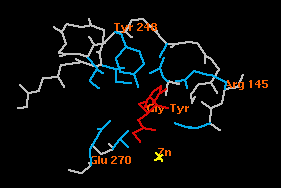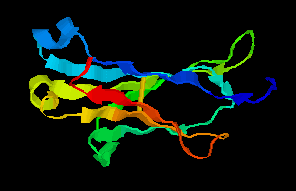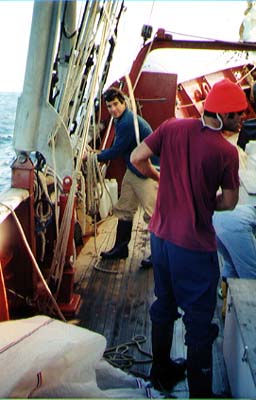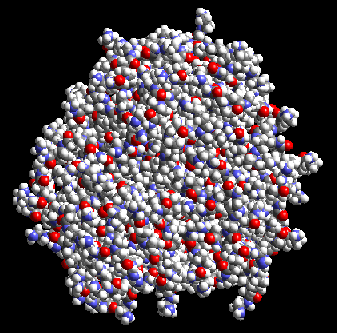Human body
Immune system
 My research projects
My research projects
Genetics

This is the active site of the proteolytic enzyme called carboxypeptidase A
that cuts at the C-terminus of a protein's peptide bond to help in digestion,
specifically targeting aromatic side chains on amino acids like
tyrosine (Tyr), as shown in the red fragment above.
Digestion
Nervous system
Liver

This is a ribbon representation of an antibody's (Ig) domain or particular repeating unit.
Each Ig domain has seven antiparallel beta strands, with two sheets
of four and three strands respectively. The two sheets are covalently linked with a
single disulphide bond (shown here as a yellow rod). The amino terminus
is blue and carboxy terminus is red.
Survey of the immune response
Immune System vs. Viruses

Here's a creative view of the brain -- through Michelangelo.
 GENETICS - under construction
GENETICS - under construction
Jordan & Caleb casting a neuston net into the sea
 My research in Fall 1999:
My research in Fall 1999:
Phosphate and Oxygen distribution in Northwest Atlantic Intermediate Waters
(SEA
Cruise 165
on board the SSV Westward, with Charles Lea as Research Director)
As part of the Westward cruise 165 down the Northwest Atlantic, six hydrocasts/CTD were collected
between 38�30' N and 11�30' N, 70�30' W and 60� W to observe nutrient vertical distributions.
CTD profiles and nutrient (phosphate, oxygen, silicate) data were obtained at up to 13 depths
between the surface and 1200m depth for each hydrocast station.
Weather Phenomenons
Woods Hole Oceanographic Institute
Scripps Institution of Oceanography (San Diego)
My research in 1998-1999:
Kinetics of dye bleaching by hydrogen peroxide on PC dye using copper dendrimer
complex as catalyst
(USF's Chemistry Dept. with Larry Margerum as Research Director)
The paper making industry has always been using chlorine as the bleaching agent
to transform the woodpulp to paper. However, this process releases toxic chloride
products into the atmosphere, causing pollution. Our research project aims to
develop an alternative bleaching method using safer bleaching agents. Our current
catalyst does increase the bleaching rates of hydrogen peroxide but is not as robust
as the iron complexes described in the literature. We're looking into trying different ratio of
the metal and the dendrimer as well as trying different metals.
Pulp & Paper Online
My research in the summer of 1997:
Synthesis of a bi-functional chelate for Gd3+ binding and dendrimer
attachment
(USF's Chemistry Dept. with Larry Margerum as Research Director)
Polycarboxylateamine chelates can bind to Gd3+
and act as MRI contrast agent, producing
better image enhancement when the MRI machine scans patients' internal tissues.
Attaching chelated Gd3+ to macromolecules like dendrimers will improve the image
resolution of the blood flow, since it prevents the chelated Gd3+
from passing through blood vessels. Synthesis of the linker and
the chelate are important precursors to the final bi-functional chelate.
The dendrimer, then, will be attached to the -NCS end of the bi-functional
chelate and Gd3+ will be added to bind all the oxygens and nitrogens
in the chelate. Analysis in my research showed successful synthesis of the linker.
The chelate was in the process of being synthesized. Below is a drawing
of the dendrimer, generation 0.0 , and a space-filling model of the
dendrimer, generation 7.0 .


Besides possibly being part of the MRI contrast agent,
the dendrimer has great potential for delivering genes to targeted cells in
gene recombination due to its large structure. If you're interested in finding out more information
about this innovative molecule, the dendrimer, here's a start:
Dendrimers on the Web
CMDR Research

 My research projects
My research projects My research projects
My research projects


 GENETICS - under construction
GENETICS - under construction My research in Fall 1999:
My research in Fall 1999: 

